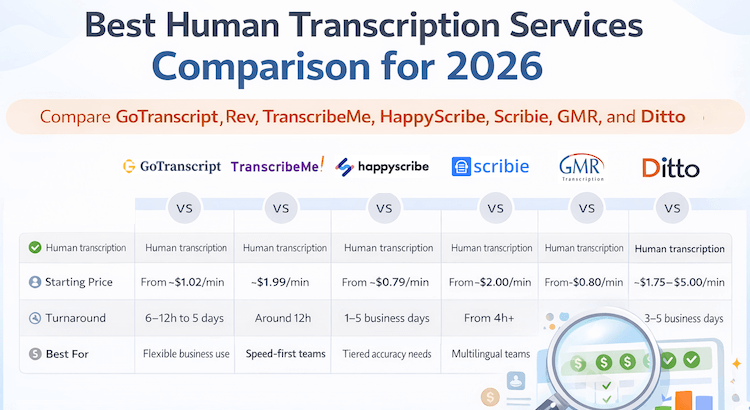What Is Medical Transcription? A Simple Guide
Medical transcription is an important part of today’s healthcare industry. This guide explains how medical transcription works, why it matters, and how professionals keep it accurate and secure. We also compare manual and automated options and show what skills a medical transcriptionist needs.
Understanding Medical Transcription
Medical transcription involves changing spoken medical reports from doctors and nurses into written text. These reports can be about:
- Patient histories
- Lab or test results
- Surgery notes
- Discharge summaries
- Other clinical information
Doctors use medical transcription to create a written record of each patient’s visits and treatments. These records may be kept in print or electronic health record (EHR) systems. The goal is to make sure health information is organized, easy to find, and accurate.
How Medical Transcription Works
- The patient sees the doctor.
- The doctor or nurse records important details using a voice recorder or phone.
- These recordings are uploaded to a secure server or app, often following HIPAA rules for privacy protection.
- A trained medical transcriptionist listens to the recording and types a written version.
- The transcribed note is proofread, corrected, and sent to the healthcare provider for final review.
- The written file is stored in the patient’s chart, either as a printed document or as part of the EHR.
If the doctor is too busy to review the text, they may approve it with a note such as “dictated but not reviewed.” If a transcriptionist is unsure about a section, they flag it for the doctor to check before marking it as complete.
The Role of the Medical Transcriptionist
Medical transcriptionists do more than just type what they hear. Their main tasks are:
- Transcribing medical voice notes quickly and accurately
- Looking up medical terms or drug names if needed
- Flagging unclear or confusing dictations
- Editing and proofreading reports for errors
- Staying updated on healthcare changes and terminology
- Protecting the confidentiality of patient information by working in secure, private spaces
Accuracy matters. A small mistake in a medical record can lead to a wrong diagnosis or treatment. Because of this, transcriptionists are trained to carefully double-check their work and use secure tools.
Benefits of Medical Transcription
1. Helps Doctors and Nurses Save Time
Transcribing medical notes is time-consuming. By outsourcing this work, healthcare professionals free up their schedules. In fact, studies show that outsourcing transcription can increase physician satisfaction and reduce burnout (AMA, 2022).
2. Lets Providers Focus on Patient Care
When doctors do not have to spend hours typing notes, they can spend more time caring for patients. This improves both healthcare quality and patient satisfaction.
3. Improves Efficiency
Having a clear, written record means doctors and staff can quickly review a patient’s medical history before making decisions. This makes every visit smoother and more productive.
4. Reduces Costs
Outsourcing medical transcription means providers only pay for each file transcribed. There’s no need to hire a full-time staff member unless necessary, saving hospitals money (AHIMA, 2022). You can see how affordable these services are on GoTranscript’s transcription pricing page.
5. Supports Legal Documentation
Transcribed medical notes are legal documents. They can be used in court or insurance cases as proof of what was said or done.
Medical Transcription vs. General Transcription
General transcription covers almost any type of speech, while medical transcription focuses just on healthcare. Medical transcriptionists need special training in:
- Grammar and medical vocabulary
- Understanding of medical records and types of files
- Confidentiality and privacy rules
- Proper formats for clinical documentation
Because healthcare has so many specialized terms, only people with medical knowledge should transcribe these kinds of files. Inaccurate transcription can lead to patient harm or even legal problems.
Medical Transcription vs. Voice-to-Text Software
Some healthcare providers use automated transcription tools or voice-to-text apps. While these can convert simple speech to text, they often make mistakes with complex or quickly spoken medical terms.
- Automated tools cannot tell the difference between similar medical words.
- They may miss important details or context from the voice recording.
- Most organizations require a trained medical transcriptionist to review and fix the machine-created transcript before storing it.
This is why medical transcription services that combine automation and human proofreading offer the best balance of speed and accuracy. Learn more about AI transcription subscriptions that include human checks.
Key Responsibilities in Medical Transcription
Maintaining Privacy and Compliance
Medical transcriptionists must follow all privacy laws, such as HIPAA. They work in secure spaces, use password-protected devices, and never share patient information.
Editing and Proofreading
Every medical transcript must be reviewed for mistakes. Professional proofreading ensures reports are clear, accurate, and ready for use by healthcare teams.
Continuing Education
Medical knowledge changes fast. Transcriptionists keep up by learning about new treatments, drugs, and medical devices. This keeps their work accurate and up to date.
Conclusion: Finding Reliable Medical Transcription Services
Medical transcription makes patient care more efficient, helps healthcare teams communicate, and ensures a clear, legal record of every visit. While automation has improved speed, human oversight is still vital for accuracy in this field.
If you need help with medical transcription, quality proofreading, or translation services, GoTranscript provides secure, accurate, and affordable options for the healthcare industry. Explore GoTranscript's full range of transcription services or order transcription tailored for your clinic or hospital today.



















 Verified Order
Verified Order